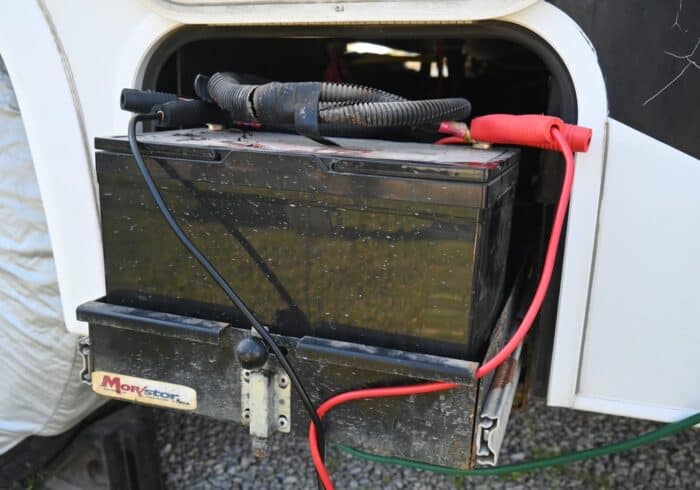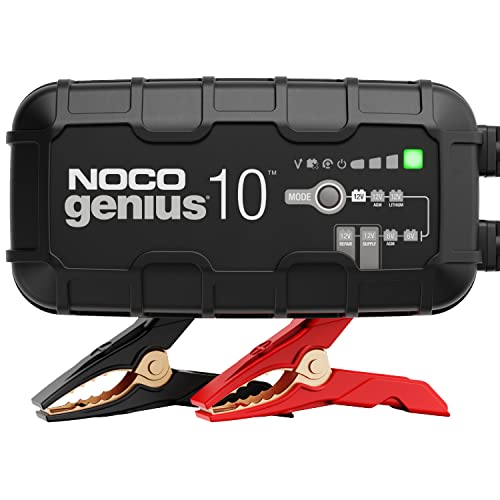Will the RV Inverter Keep My Motorhome Chassis Battery Charged?
There are generally two batteries in motorhomes.
One that’s for running the 12 volt appliances inside the RV, also called the house battery.
Then there’s the automotive battery that’s for the engine, also called the chassis battery.
Related Product: We use the reliable VMAX 100Ah AGM battery (click to view on Amazon) in our RV.
In most cases, the RV inverter will not charge the RV chassis battery.
This isn’t a problem if you drive your motorhome once every few months to recharge the battery.
But if you are planning on staying in an RV park over the winter or longer, you are going to need to keep that 12 volt engine battery maintained.
One thing to note is there is usually a switch somewhere on the driver’s side of the cab that is for jump starting the RV chassis battery with the house batteries if it dies.
I’ve never had to use this feature but it’s good to know about if you’re ever camping far away from humanity and your motorhome won’t start because of a dead chassis battery.
Here are a few ways you can keep the chassis battery in your RV charged if you won’t be driving it for a while.
See Also: When To Charge A Deep Cycle Battery
Ways to Keep an RV Chassis Battery Charged
1. Start the Engine
The simplest but most time consuming way to keep your RV chassis battery charged when parked for a long time is to start the engine and let the alternator do its thing.
Driving it around is how vehicles keep their batteries charged so starting the engine for a while should help keep the starting battery in good health.
The main downside to this method is it’s going to be noisy since the engine will have to be running and it will use up fuel.
If you’re in an RV park or campground with lots of neighbors they might not appreciate the noise.
It’s also the most inefficient way to keep the RV chassis battery charged but in a pinch it’s one way to do it.

2. External Battery Charger
The most common way RVer keep their batteries charged when plugged into shore power is with good old fashioned trickle or smart chargers.
You can actually disconnect the house batteries when you are plugged into a main power supply and you will want to make sure you keep those charged up as well.
I recommend getting a good smart charger over a trickle charger since they will not damage your batteries if left connected a battery for a long time.
NOCO Genius10 Smart Battery Charger (for all battery types)
They can normally also charge lots of different types of batteries which is useful if you have lithium or AGM house batteries and a flooded lead acid chassis battery.
For this method, you can either get a few smart battery chargers or periodically transfer the charger to each battery that needs to be charged.
A good chassis battery should only need to be charged once every few months but some motorhomes might have things connected that leach power.
See Also: Best Deep Cycle Battery Chargers Reviewed (12V, 6V, RV, AGM)
Over time you will start to learn how fast the chassis battery discharges on its own and you can adjust your charging schedule accordingly.
You can also get a battery meter that connects to the chassis battery with a screen in the cab or somewhere you can easily see it.
DROK 12V Battery Capacity & Temperature Monitor
I recommend getting a battery meter even if you use the built in battery charger method below because you will want to know if the charger is working correctly.
Since the built in battery meters in RVs can be very inaccurate I recommend getting one for the house batteries as well.
It’s a super simple install that’s worth it since a battery meter can help keep your batteries from discharging to damaging levels.
Healthy batteries last longer and won’t need to be replaced as often.
3. Built-In Battery Charger
If you plan on leaving your RV house batteries connected so the inverter will charge them while you are parked and plugged into shore power there is a built-in chassis battery charger option that’s easy to install.
See Also: How To Install Solar Panel On RV Roof & Connect To Battery
This option also works if you have an external battery charger or solar panel connected to your RV house batteries so they stay charged and have enough juice left over to keep the chassis battery charged.
The Xantrex Echo connects your RV house batteries to the chassis battery.
It then draws power from the charger connected to the house batteries and uses that to maintain the other battery it’s connected to.
It will only switch on when the house batteries are being charged, so it won’t kill the RV batteries to keep the chassis battery alive.
This also keeps the Xantrex from overcharging the battery, which means it’s better than a standard trickle charger that’s constantly charging no matter what.
It can charge 12 or 24 volt batteries and it will automatically adjust for either kind.
The max output amperage is 15. When connected to a 12 volt battery the charger will switch on when the battery discharges to 13.0 volts, 26.0 volts on a 24 volt system.
The unit has over-voltage and thermal protection as well.
See Also: Should I Disconnect My RV Battery When Plugged In?
The main thing you will need to think about when installing the Xantrex Echo Charge will be the placement of the charger.
It needs to be no more than 2 feet from either the RV chassis battery or the house batteries in a dry, clean, well ventilated area.
In most cases, you should be able to install it somewhere inside the motorhome because the house batteries are usually located just underneath the floor.
The battery compartment is also a great option.
If the chassis battery isn’t too far away you could also install it somewhere in the cab.
There are some necessary cables, battery connectors, and fuses included, but you will probably also need some extra wire to extend the connection between the charger and the other battery.
Xantrex recommends using 12 gauge wire (click to view on Amazon) as extension wires even though the included wires are 16 gauge.
An installation diagram and more instructions are included with the battery charger.
As I said in the above section I recommend getting a battery meter (click to view on Amazon) for the RV chassis battery since there’s always a chance that something isn’t working with the charger.
That way you can catch and correct any issues before the chassis battery gets completely discharged and damaged.
Have any more questions about charging an RV chassis battery when long term camping? Leave a comment below.





Hi Jenni,
I’m hoping you can help me. We have a 1999 Minnie Winnie Class C RV. There is a disconnect switch to keep the “house” from draining the house and chassis batteries. We’ve never had any trouble with the cabin battery. The truck is an F350, V-10 Triton Engine. We are now on our 3rd chassis battery in 3 years. My theory is the disconnect switch is not actually disconnecting, but I’m just guessing. So, we have tried trickle charging and cranking the truck every 2 weeks, which seemed to work for a while, but then had to bump it to cranking once a week, and then last week our 1 year old chassis battery just died. Again! Can you recommend the best AGM, Gel or Lithium battery for the chassis? I know they’re more expensive, but at this point, we don’t really care. Also, is it okay to just leave the chassis battery disconnected instead of trusting our “trickle charge/cranking system” to help extend the life of the battery? Something is draining and killing these batteries at a frightening rate and we have to figure it out. I love camping and my husband loves me, but he’s about the get rid of me and the camper! : / Thanks!
Hi Janet,
Sorry to hear about your battery issue, it does sound like something is draining the battery that shouldn’t be.
The battery disconnect switch only works on the house battery, it doesn’t disconnect the chassis battery.
Does your RV have an electric step? The electric steps are powered by the chassis battery and they can drain a battery really quickly. If you have an electric step you should set it so it stays out while you’re camping.
Also, if there’s a backup camera connected to the chassis battery that could also be the issue. You may have to turn it off manually to make sure it isn’t draining the battery.
Disconnecting the chassis battery is a good way to make sure nothing will drain it while you’re camping. If you disconnect it and it still dies there’s something wrong with the battery. A regular car battery should be able to hold a charge for months when it’s not connected to anything.
If there’s something draining the battery getting an AGM or lithium probably won’t help much. But if you still want to get one I recommend going to a car parts store so they can help you get the correct size.
I think finding the source of what’s killing the battery is the best way to go. If you need more help figuring it out feel free to leave another comment.
Hopefully, we can get the issue fixed before you and the camper get thrown out!
Hi,
I have a 2017 Winnebago Spirit parked and plugged in to 30 amp shore power. Living in it. I bought a solar trickle charger for my chassis battery but very cloudy, it’s not keeping up. This morning it was clicking inside the cab. I tried starting but had to boost off the rv (switch in cab). I have been running the truck for 15 minutes every day or so and not using cab stuff like radio. Is there any way to stop it from draining. Battery was new in August. The coach battery switch in the rv is always on as i have an norcold fridge. Help!
Hi Lynda,
The chassis battery definitely shouldn’t be draining like that. It’s hard to know what the problem might be but one way you could stop it from draining is to disconnect from your RV completely so absolutely nothing could be taking power from it.
Once disconnected the solar trickle charger should be able to keep it charged.